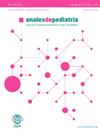儿童血管异常。回顾与更新
IF 1.5
4区 医学
Q2 PEDIATRICS
引用次数: 0
摘要
血管异常是指血管发生变化,通常出现在胎儿期、出生时或幼儿期。血管畸形可导致慢性疼痛、运动障碍、外观变化或凝血功能障碍,在某些情况下可能致命,但在任何情况下都会对儿童和家庭的生活质量造成负面影响。已描述的亚型多达 150 种。它们可能涉及动脉、毛细血管、静脉、淋巴管或它们的组合。它们可能伴有其他畸形,并经常导致肌肉骨骼和软组织肥大或萎缩。它们可在身体任何部位发病,侵犯任何组织,并影响各种器官的功能。不同亚型的发病率差别很大,从 1/20 到 1/1 000 000。在欧盟,被认为是罕见病的亚型(发病率为 1/2000)仍然影响着 50 多万人。区分血管肿瘤和血管畸形至关重要,尤其是在儿科患者中。血管畸形的临床评估中使用的诊断算法应基于全面的病史采集和详细的体格检查。目前正在探索新的分子及其适应症,目的是降低以往治疗的侵袭性,延长对传统治疗无效患者的寿命,提高其生活质量。本文章由计算机程序翻译,如有差异,请以英文原文为准。
Anomalías vasculares en la infancia. Revisión y actualización
Vascular anomalies are changes in vascularization that usually appear in the foetal stage, at birth or in early childhood. They can cause chronic pain, motor impairment, cosmetic changes or coagulopathy and may be fatal in some cases, but in every case they have a negative impact on the quality of life of the child and the family. Up to 150 different subtypes have been described. They can involve arteries, capillaries, veins, lymphatic vessels or a combination thereof. They may be associated with additional malformations and frequently cause musculoskeletal and soft tissue hypertrophy or hypotrophy. They can develop anywhere in the body, invade any tissue and affect the function of various organs. The prevalence of the different subtypes varies greatly, from 1/20 to 1/1 000 000. Subtypes considered rare diseases (incidence < 1/2000) continue to affect more than 500 000 people in the European Union.
Differentiating between vascular tumours and vascular malformations is critical, especially in paediatric patients. They are completely different diseases, although they are often grouped under the umbrella term of vascular anomalies.
The diagnostic algorithm used in the clinical evaluation of vascular anomalies should be based on a thorough history-taking and detailed physical examination.
Future knowledge in this field will be based above all on genetic findings and therapeutic innovations. New molecules and their indications are being explored with the aim of reducing the aggressiveness of previous treatments and increasing the life expectancy and quality of life of patients who do not respond to conventional treatments.
求助全文
通过发布文献求助,成功后即可免费获取论文全文。
去求助
来源期刊

Anales de pediatria
医学-小儿科
CiteScore
2.10
自引率
4.80%
发文量
155
审稿时长
44 days
期刊介绍:
La Asociación Española de Pediatría tiene como uno de sus objetivos principales la difusión de información científica rigurosa y actualizada sobre las distintas áreas de la pediatría. Anales de Pediatría es el Órgano de Expresión Científica de la Asociación y constituye el vehículo a través del cual se comunican los asociados. Publica trabajos originales sobre investigación clínica en pediatría procedentes de España y países latinoamericanos, así como artículos de revisión elaborados por los mejores profesionales de cada especialidad, las comunicaciones del congreso anual y los libros de actas de la Asociación, y guías de actuación elaboradas por las diferentes Sociedades/Secciones Especializadas integradas en la Asociación Española de Pediatría.
 求助内容:
求助内容: 应助结果提醒方式:
应助结果提醒方式:


